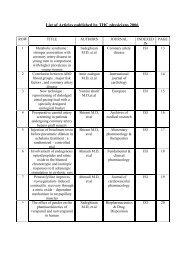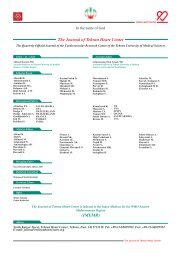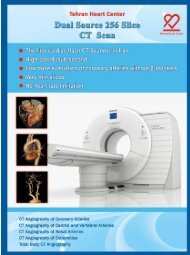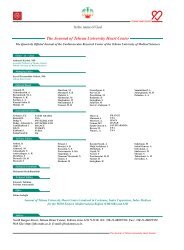Journal of Tehran University Heart Center
Journal of Tehran University Heart Center
Journal of Tehran University Heart Center
You also want an ePaper? Increase the reach of your titles
YUMPU automatically turns print PDFs into web optimized ePapers that Google loves.
TEHRAN HEART CENTER<br />
Letter to the Editor<br />
Percutaneous Revascularization<br />
<strong>of</strong> Patients with History <strong>of</strong><br />
Coronary Artery Bypass<br />
Grafting<br />
Special thanks are due to Dr. Fatemeh Behboudi et al.<br />
for their invaluable work on percutaneous intervention on<br />
grafted veins as well as native coronary arteries in patients<br />
with previous history <strong>of</strong> coronary artery bypass graft )CABG)<br />
surgery. 1 They report 71 patients with a history <strong>of</strong> CABG,<br />
in whom percutaneous coronary intervention (PCI) was<br />
performed on native vessels in 60%, on grafted vessels in<br />
32%, and on both in the remaining 8%.<br />
In the modern era <strong>of</strong> cardiovascular medicine, CABG<br />
and PCI are not rivals but could be complementary to each<br />
other. With the increasing age <strong>of</strong> patients with a history <strong>of</strong><br />
CABG, atherosclerotic changes progress in their native as<br />
well as grafted vessels. Within 10 years after CABG, nearly<br />
half <strong>of</strong> saphenous vein grafts (SVGs) fail or demonstrate<br />
significant atherosclerotic disease and the patients become<br />
symptomatic. 2 Atherosclerotic plaques in SVGs are always<br />
complex and friable and may be associated with thrombus. 3<br />
The first approach to the symptomatic stable post-CABG<br />
patient is optimizing medical treatment as well as assessing<br />
the amount <strong>of</strong> myocardium in jeopardy and localizing the<br />
ischemia by non-invasive tests such as imaging modalities.<br />
In case <strong>of</strong> medical treatment failure or high-risk non-invasive<br />
test results, or if the presentation <strong>of</strong> the patient is acute<br />
coronary syndrome, coronary angiography may be indicated<br />
and revascularization is on the table. Redo CABG could be<br />
an option, but there are some obstacles. Higher mortality<br />
and morbidity has been reported compared with first CABG,<br />
especially in subjects with advanced age and with comorbid<br />
states. 4 Sternotomy could be a potential hazard for the<br />
grafted internal mammary artery. The second approach is<br />
PCI on either native coronary arteries or grafted vessels or<br />
both whenever feasible and is indicated based on the area <strong>of</strong><br />
the ischemia. PCI is <strong>of</strong>ten the preferred treatment option in<br />
this population since reoperation imposes substantial risk on<br />
these subjects.<br />
The study conducted by Dr. Behboudi and her colleagues<br />
is a report on in-hospital and mid-term outcome <strong>of</strong> PCI on<br />
patients with a previous history <strong>of</strong> CABG. The favorable<br />
outcome <strong>of</strong> the subjects in this study encourages the<br />
cardiologists to perform PCI on this group <strong>of</strong> patients.<br />
Whether the native vessel or the SVG is preferable for PCI<br />
is not answered in this survey. The target vessel for PCI in<br />
post-CABG patients is sometimes a matter <strong>of</strong> debate, and<br />
the selection <strong>of</strong> the native vessel or SVG with significant<br />
stenosis for intervention is not always a simple decision. A<br />
comparison <strong>of</strong> the major adverse cardiac events (MACE)<br />
rate, procedural complications, and outcome between the<br />
two groups can help solve this problem.<br />
The percutaneous treatment <strong>of</strong> the SVG has been a matter<br />
<strong>of</strong> interest for many years, and there is a large body <strong>of</strong> data on<br />
this procedure. The SVG could be a target because <strong>of</strong> lesser<br />
tortuosity, less calcification, and larger diameter compared<br />
with native vessels. The mechanisms <strong>of</strong> stenosis in the SVG<br />
are somehow different from those in native coronary arteries. 3<br />
Native coronary artery and SVG atherosclerosis should be<br />
considered different diseases. Atherosclerotic plaques in the<br />
graft are more diffuse, friable, s<strong>of</strong>t, and lipid-rich. These<br />
characteristics render SVG lesions prone to fragmentation<br />
and distal embolization during PCI. 5 The incidence <strong>of</strong> no<br />
reflow and rate <strong>of</strong> periprocedural myocardial infarction<br />
are higher in SVG angioplasty, owing in large part to the<br />
embolization <strong>of</strong> the abundant and friable atherosclerotic<br />
debris in diseased SVGs. 3, 6 The use <strong>of</strong> embolic protection<br />
devices (EPDs) has been demonstrated to reduce the<br />
major adverse cardiac events rate as well as no reflow in<br />
SVG angioplasty 7 and these devices are recommended in<br />
guidelines whenever technically feasible. 8 Despite these<br />
supporting data, EPDs are used only in 22% <strong>of</strong> patients in<br />
the United States. 9<br />
In this study, Dr. Behboudi et al. mention that PCI on<br />
post-CABG patients is feasible and safe. A challenge is that<br />
which vessel is better for intervention ,the native vessel or the<br />
SVG Was there any difference in the MACE rate between<br />
the group who underwent PCI on their native coronaries<br />
and those with intervention on their SVGs It seems that the<br />
sample size was not sufficient for such an analysis. Provision<br />
<strong>of</strong> information on the no-reflow rate in the SVG group and<br />
utilization rate <strong>of</strong> EPDs would be helpful. There is room<br />
for investigation about the procedural time, radiation dose,<br />
and amount <strong>of</strong> contrast injection in SVG intervention and<br />
a comparison with PCI on native vessels in post-CABG<br />
patients.<br />
We will encounter more symptomatic post-CABG patients<br />
in the future. More PCI procedures will be carried out on<br />
these patients either on their native or their grafted vessels.<br />
More data are needed to help select the best target vessel<br />
to obtain maximal efficacy and minimal risk. Sometimes<br />
we have to open as much vessel as we can, especially when<br />
the patient remains symptomatic despite opening one target<br />
vessel.<br />
The important role <strong>of</strong> optimal medical treatment should<br />
The <strong>Journal</strong> <strong>of</strong> <strong>Tehran</strong> <strong>University</strong> <strong>Heart</strong> <strong>Center</strong>95
















